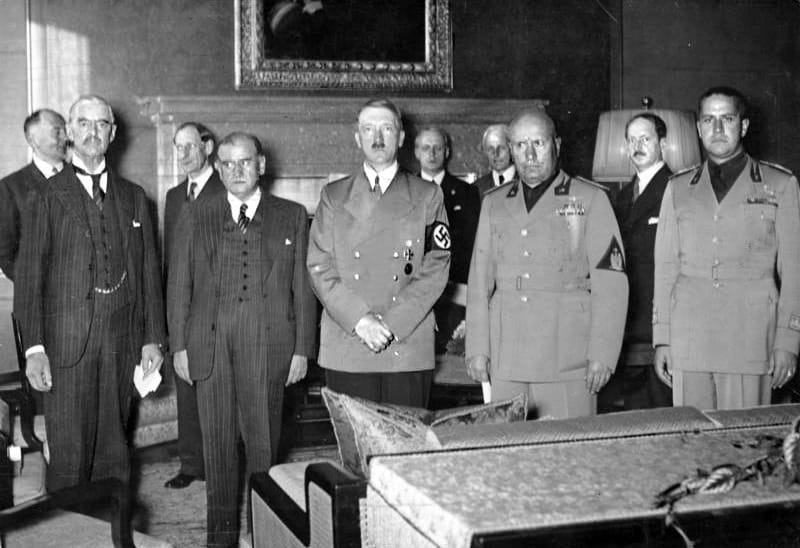
Galeazzo Ciano (far right) standing alongside (right to left) Benito Mussolini, Adolf Hitler, Édouard Daladier, and Neville Chamberlain prior to the signing of the Munich Agreement. Ciano, Italy’s foreign minister under Mussolini, fled Italy with wife Edda and their three children to Germany on 28 August 1943, in fear of being arrested by the new Italian government, but the Germans turned him over to Mussolini’s administration. He was then formally arrested on charges of treason. Under German and Fascist pressure, Mussolini had Ciano imprisoned before he was tried and found guilty. After the Verona trial and sentence, on 11 January 1944, Ciano was executed by a firing squad along with 4 others (Emilio De Bono, Luciano Gottardi, Giovanni Marinelli and Carlo Pareschi) who had voted for Mussolini’s ousting. As a further humiliation, the condemned men were tied to chairs and shot in the back, though according to some accounts, Ciano managed to twist his chair around at the last minute to face the firing squad before uttering his final words, “Long live Italy!” (Wikipedia under heading “Galeazzo Ciano.”)
By Phil Kohn. Dedicated to the memory of his father, GM3 Walter Kohn, U.S. Navy Armed Guard, USNR, and all men and women who have answered the country’s call in time of need. Phil can be contacted at ww2remembered@yahoo.com.
Despite desperate German resistance, Kirovgrad, Ukraine, falls to the Red Army’s 2nd Ukrainian Front on January 7, 1944.
On January 8, Filipino troops begin engaging Japanese forces in the province of Ilocos Sur, Luzon, the Philippines. In Verona, Italy, the government of the Italian Social Republic tries 19 members of the former Fascist Grand Council who had earlier voted to depose Mussolini, including former Foreign Minister Count Galeazzo Ciano, Mussolini’s son-in-law. Five of the six defendants in custody are convicted and condemned to death; the 13 others not in custody are convicted and condemned to death in absentia. (The one defendant who escaped the death penalty had written a letter of apology to Mussolini. He was sentenced to 30 years in prison.)
The British XV Corps on January 9 captures Maungdaw, an important port for delivery of Allied supplies in western Burma.
The Red Army captures Ludwipol, eight miles across the pre-war Polish border on January 10. The Soviets propose establishing a new Polish border that would be farther west.
On January 11, 660 heavy bombers of the U.S. 8th Air Force carry out attacks against industrial targets at Braunschweig, Magdeburg and Ascherleben, Germany. In Italy, Count Galeazzo Ciano, the former Italian foreign secretary and Mussolini’s son-in-law, is executed by firing squad in Verona. His “crime” is having voted with other fascists to oust Mussolini from office in July 1943. (Ciano and his wife had been lured to Bavaria in August 1943 following a report that their children were in danger. Having been promised safe passage to Spain by the Nazis, they were instead handed over to Mussolini’s fascist puppet government in northern Italy.) In Asia, the British submarine HMS Tally-Hotorpedoes and sinks the Japanese light cruiser Kumaoff Penang, Malaya. About a third of the Japanese crew is lost.
British and French leaders Winston Churchill and Charles de Gaulle begin a two-day conference in Marrakesh, Morocco, on January 12. They discuss the participation of French troops in the Allied invasion of Europe and the post-war administration of France. In Asia, some 12,000 Chindits — British and Indian long-range-penetration troops organized for conducting raids — are behind Japanese lines in Burma. They are led by Brig. Gen. Orde Wingate.
In Italy, near Cassino, Moroccan and Algerian troops of Gen. Alphonse Juin’s (Free) French Expeditionary Corps (Corps Expéditionnaire Français) cross the Rapido River and advance to the main defenses of the Germans’ Gustav Line on January 13. Their success gives U.S. Fifth Army headquarters a bit of renewed optimism.





